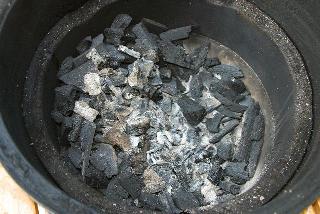Welcome to the EGGhead Forum - a great place to visit and packed with tips and EGGspert advice! You can also join the conversation and get more information and amazing kamado recipes by following Big Green Egg to Experience our World of Flavor™ at:
Want to see how the EGG is made? Click to Watch
Facebook | Twitter | Instagram | Pinterest | Youtube | Vimeo
Share your photos by tagging us and using the hashtag #BigGreenEgg.
Share your photos by tagging us and using the hashtag #BigGreenEgg.
Want to see how the EGG is made? Click to Watch
lump longevity and heat control
Options
i have two questions for the 'eggs-pert' panel. firstly, i have been reading through the message board and found alot of good slow cook / smoking recipes that call for cooking something (ie. a boston butt) on low heat (200-250 degrees) for up to as much as 20 hours. Is that possible on one 'load' of lump coal. the biggreenegg homepage says you can cook "as much as 8 hours" but they may be talking about higher heats that burn lump faster. on low heat (200-250) how long will a good load last and if long haul recipes require a reload, is there any trick to this.[p]my second question deals with heat regulation. i have a medium egg with a daisy wheel. is anything published that tells what setting (inches at the bottom opening and top wheel position) corresponds roughly with temperature. i seem to get it real hot and then choke it down too cool and then heat it back up. i realize its a matter of experience, which i currently dont have but wondered if there were any rules of thumb for certain temps, say: 200, 300, 400 and 500.[p]thanks in advance for any input and next time i will hopefully have a good recipe to share.[p]greenegg greenhorn.
Comments
-
atlantaegg, I have a large BGE and have done a slo cook at about 250° for 16 hours and still had some lump left. this was with the lump filled up to a couple of inches below the top of the fire ring. The medium doesn't hold quite as much lump so there would be some difference in max time that you could expect; I don't think that it would be a lot less though.[p]As for setting the vents, I know approximately where to set my vets for certain temperatures but there is usually some small amount of variance caused by things like type of lump, size of lump, new or left-over lump, the way the daisy sets on the top, etc.[p]What I finally learned was to do most of the control with the daisy. For high temp cooks(350° and above) it is usually wide open and I use the slide portion of the daisy. For lower temps I close it to about 1 inch and then use the daisy to dial in the desired temp. This is the easiest way to get uded to your vent settings. If you try to adjust both vents at the same time you can drive yourself crazy learning what works.[p]
-
CR, not clear in my first post was that when I said the vent was wide open or about 1 inch open I was talking about the lower vent and then controlling with the top(daisywheel).
-
<p />atlantaegg,

On a large egg, if you load it up halfway up the firering, you will have more than enough lump for 20 hours. This is a photo of what I had left after a 20 hour cook.[p]As for heat regulation, there is no published recommendation that I know of for vent openings vs. temperature. However, the approach that most people find successful for getting to a temp and then regulating it is to start your fire and watch the temp rise. Say 25-50 degrees before your target temp, start shutting the vents and slowly approach your target from below. It is easy to get the egg to heat up and more difficult to get it to cool down. After you have done this a number of times, you'll get to know what vent settings give you different temperatures. Good luck![p]TNW
The Naked Whiz
Categories
- All Categories
- 182.7K EggHead Forum
- 15.7K Forum List
- 459 EGGtoberfest
- 1.9K Forum Feedback
- 10.3K Off Topic
- 2.2K EGG Table Forum
- 1 Rules & Disclaimer
- 9K Cookbook
- 12 Valentines Day
- 91 Holiday Recipes
- 223 Appetizers
- 516 Baking
- 2.4K Beef
- 88 Desserts
- 163 Lamb
- 2.4K Pork
- 1.5K Poultry
- 30 Salads and Dressings
- 320 Sauces, Rubs, Marinades
- 543 Seafood
- 175 Sides
- 121 Soups, Stews, Chilis
- 35 Vegetarian
- 100 Vegetables
- 313 Health
- 293 Weight Loss Forum